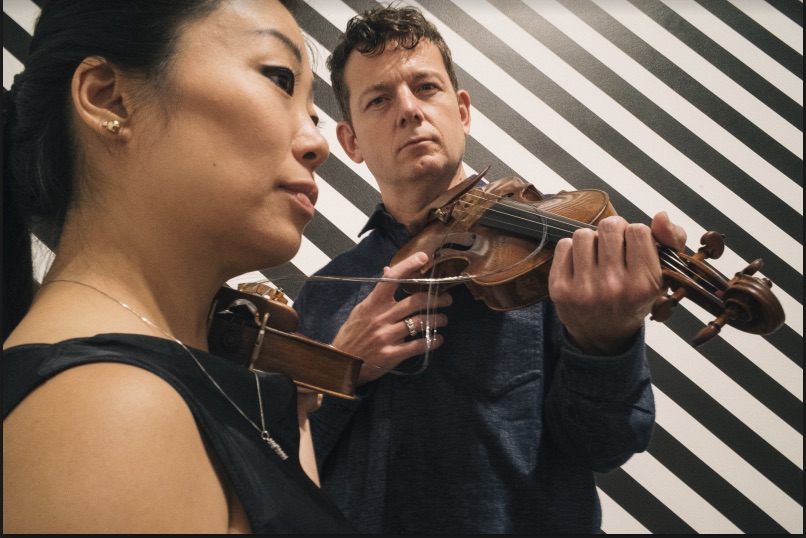Fabric for String Noise in Two Parts composed by Michael Byron was completed at the invitation of Conrad Harris and Pauline Kim‐ Harris. They first spoke of this idea about five years ago.
Fabric for String Noise in Two Parts is cast in two parts. This “sound object” is tangible, compact, and marked by extreme polyrhythmic complexity, and intricate contrapuntal textures. One dominating factor throughout is an adherence to the principle of multiplicity. In the work’s formal organization, the development of intervallic correlations is primary; its harmonic relationships, ancillary. According to musical criteria, Fabric was composed using only the higher registers of the violin, sharpening the music’s edge, and crystalizing the perceptual object.
The formidable virtuosity necessary to navigate through the complex rhythms and negotiate the interweaving and crisscrossing of Fabric is substantive. The dedicatees, Conrad Harris and Pauline Kim‐ Harris are exceptionally skilled at overcoming exactly such difficulties. Their performance of Fabric is seamless; their necessary physical endurance, stunning.
‐‐Michael Byron
Fabric for String Noise was sponsored by Harvestworks, and will be released this fall on COLD BLUE RECORDS.
Saturday, Sept. 15, 2018
Location: Tenri Cultural Institute,
43A W 13th St, New York, NY 10011
Tickets: $20 / $15 for students/seniors
About the Duo
String Noise is a classical, avant-punk violin duo comprised of violinists Conrad Harris and Pauline Kim Harris. Since its inception in 2011 at Ostrava New Music Days, they have expanded the two violin repertoire in over 50 new works to include larger collaborations with multimedia art, electronics, video projections, opera and dance.
Their first feature album “The Book of Strange Positions” was released on NORTHERN SPY RECORDS in November 2015. Tiny Mix Tapes describes this collection of original works and arrangements by Eric Lyon of punk covers by Bad Brains, Violent Femmes, Deerhoof, Radiohead, and Black Flag as a “mix of classic punk covers and ZERO APOLOGIES.” Their 7” inch EP “Covers” produced by Deerhoof drummer and composer Greg Saunier is also available on Northern Spy Records.
String Noise was highlighted in Performa 2011 with artist Will Cotton and was the featured ensemble for the launch of composers collective Indexical (David Kant, Andrew Christopher Smith, Mustafa Walker and Beau Sievers). Premieres by String Noise include works by Christian Wolff, John King, Phill Niblock, Caleb Burhans, David Lang, Petr Kotik, Du Yun, Annie Gosfield, Bernhard Lang, Spencer Topel, Derek Hurst, Jerome Begin, Elizabeth Hoffman, John Zorn, Greg Saunier, Alex Mincek, Yoon-Ji Lee, Catherine Lamb, Petr Bakla, Richard Carrick and Alvin Lucier, to name some. String Noise has performed at Issue Project Room, Czech Center, Roulette, EXAPNO, Rockwood Music Hall and the Stone and has been heard on WNYC, WKCR and WFMU.
About the Composer
Michael Byron (born September 7, 1953 is an American composer and editor of contemporary music anthologies.
In 1971, he met, and began studying with James Tenney, at the newly built California Institute of the Arts. At around the same time, he was introduced to Harold Budd, and Richard Teitelbaum (two lifelong musical friends), and soon thereafter Lou Harrison, Dane Rudhyar, and Robert Ashley. During the halcyon days of the early 1970s, his music—its compositional trajectory—was one of extreme reductionism.
In 1973, he moved from Los Angeles to Toronto to study with Richard Teitelbaum at York University. For reasons unrelated to the geographical change, the allure of reductive music passed as quickly as it had come. In the winter of 1973-1974, he began composing Starfields, for piano four hands. Starfields was his first work using an ergodic form, and stochastic processes adhering to the principle of multiplicity.
Byron also began the publishing experiment, Pieces, a series of anthologies devoted to the increased dissemination and visibility of radical directions in music. He later served on the Board of Directors of the Aesthetic Research Center of Canada, where he edited The Journal of Experimental Aesthetics.
In 1975, along with visual artist Jackie Humbert, composer David Rosenboom, and filmmaker George Manupelli he co-founded the multidisciplinary performance-art group, Maple Sugar. Finally, in the winter of 1976-1977, with the encouragement of composer Lou Harrison, he moved permanently to New York City.
There, he composed prolifically, but also worked on the periphery of the art rock/punk/noise works with Rhys Chatham and others, in lower Manhattan’s club scene. In 1979, he was hired by the DIA Art Foundation to work as assistant to La Monte Young.
Over the last four decades, working independently, Byron has created a rigorous body of work marked by extreme polyrhythmic complexity, and intricate contrapuntal textures that have become a hallmark of his style. This music is exclusively virtuosic.
His music has been recorded on New World Records, Cold Blue Music, Meridian Records, Poon Village Records, Neutral Records, Tellus, Koch Records, and Bandcamp. His scores are published, and distributed by Frog Peak Music.






